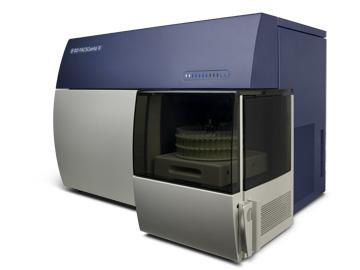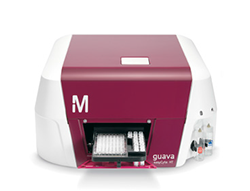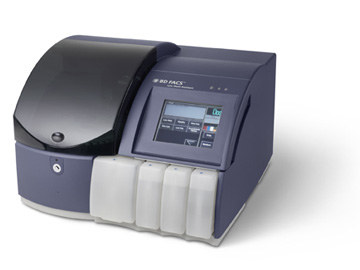Aurora CS-High Speed Spectral Cell Sorter
- 5 laser system: 355 nm, 405 nm, 488 nm, 561 nm, 640 nm
- 64 channels- Detect up to 40 colors
- Violet detector module: 16 channels; bandwidth from 420-829nm
- Blue detector module: 14 channels; bandwidth from 498-829 nm
- Red detector module: 8 channels; bandwidth from 652-829 nm
- Yellow-Green detector module: 10 channels; bandwidth from 567-829 nm
- Ultraviolet detector module: 16 channels; bandwidth from 365-829 nm
- Adjustable Sample Flow Rates in increments of 7 μL/min from 10 μL/min to 80 μL/min
- 4 to 37°C (39.2 to 98.6°F) for both sample input and output
- Custom plate options available
- Nuclei and EV/small particle sorting
- Up to 6-way sorting
- 96-well and 384-well plates with index sorting
- See Full List of Tested Fluorochromes

Aurora Spectral Cell Analyzer
- 5 laser spectral and conventional analyzer
- 64 fluorescence channels, 40-50 color/marker
- Violet detector module: 16 channels; bandwidth from 420-829nm
- Blue detector module: 14 channels; bandwidth from 498-829 nm
- Red detector module: 8 channels; bandwidth from 652-829 nm
- Yellow-Green detector module: 10 channels; bandwidth from 567-29 nm
- Ultraviolet detector module: 16 channels; bandwidth from 365-829 nm
- Exceptionally sensitive
- Both tube and plate mode
- High resolution
- Autofluorescence feature
- Small particle applications
- See Full List of Tested Fluorochromes

Northern Lights Spectral Cell Analyzer
- 3 laser spectral and conventional analyzer
- 24 marker/color detection
- Exceptionally sensitive
- Both tube and plate mode
- High resolution
- Autofluorescence feature
- See Full List of Tested Fluorochromes

Attune NxT Flow Cytometer with CytKick Max Autosampler
A four laser, 14 Color and 16 detector analyzer with 488nm, 637nm, 405nm and 561nm wavelength laser system. It is a highthrouput system, capable of high-performance analysis for assays like cell proliferation, immunophenotyping, cell cycle, apoptosis etc. Attune NxT system with autosampler is an easy-to-use benchtop analyzer that delivers proven performance, accuracy and high-quality results. The Attune features many innovations, including:
- Acoustic focusing: Combining ultrasonic waves like those used in medical imaging with hydrodynamic forces to precisely position cells into a single, focused line in the central axis. Enabling cells to be tightly focused at the point of laser interrogation allows the system to collect more photons, helping to ensure data quality regardless of the sample-to-sheath ratio.
- Fast, accurate acquisition: Acoustic focusing also lets your lab rapidly acquire high-quality data. You can achieve sample throughput rates of 12.5 µL/min or 1,000 µL/min, up to 10 times faster than traditional hydrodynamic focusing systems and acquisition speeds of 35,000 events per second. This means you can process all of your samples—including low-concentration and precious samples—more quickly and accurately with minimal loss in quality.
- Rare event detection: Detection of rare events requires acquisition of high numbers of cells to attain a reliable measure of accuracy. Attune Flow Cytometers allow dilute samples to be processed quickly at sample input speeds of up to 1 mL/min, significantly faster than conventional cytometers that support maximum sample input rates of 60–100 µL/min. Acoustic focusing thus offers a unique combination of speed and quality, cutting the time to collect rare events significantly over long acquisition times.
- Designed for flexibility: Attune Flow Cytometers are configurable with up to 4 spatially separated lasers and 16 parameters. Spatial separation provides flexibility for multicolor panel design and streamlines compensation. The system offers superior speed with acquisition rates of up to 35,000 events per/second with high sensitivity to meet a range of research requirements. High sensitivity distinguishes between dim signals and background, resulting in less variation and better signal separation.
- Novel optical design: That delivers first-class reliability and superior performance over time. The flat-top beam profile of the solid-state lasers minimizes the effects of changes in fluidics or optics. Attune has spatially separated lasers and 16 parameters. Spatial separation provides flexibility for multicolor panel design and streamlines compensation. The system offers superior speed with acquisition rates of up to 35,000 events per/second with high sensitivity to meet a range of research requirements.
- Clog-resistant technology: To prevent clogging and allow for volumetric analysis, the Attune Flow Cytometers use a positive displacement syringe pump to control sample volume. The system can perform volumetric cell counts in a known volume (gated or total events) and can easily gate out dead cells to count live cells only in a live/dead analysis. Unlike traditional cytometers that operate at a maximum pressure of 15 PSI, Attune Flow Cytometers control pressure at 75 PSI, reducing the likelihood of cell-cell interactions and resulting in clog resistance.
- Powerful, intuitive software: The Attune Cytometric Software is designed to provide powerful data acquisition and analysis using an intuitive user-friendly interface. Experiments can easily be set up, customized, and saved for future studies. Compensation is automated and can be set up using a guide. The software is designed to maximize efficiency in performing data analysis, with fast refresh rates for large data sets (up to 20 million events per sample) with the ability to immediately visualize changes on data plots as you make adjustments.
- High Throughput: 22 min for 96-well plate (Boost mode, using one rinse and one mix and full analysis of a 20 µL sample.
- Carryover:
- <0.5% carryover for 100 μL, 200 μL, 500 μL, and 1,000 μL samples with one mix and one rinse in standard mode
- <1.0% carryover for 12.5 μL and 25 μL samples
- <1.0% carryover for 500 μL and 1,000 μL samples in Boost mode with one mix and one rinse
- Compatibility:
- 96 deep-well
- 96-well standard depth
- 384 deep-well
- 384-well standard depth
- 1.5 mL and 2 mL microcentrifuge tube rack (up to 24 per rack)
- 96-well foil covered
- 84-well foil covered customizable to accept additional plate types
- Cooling: Passive cooling available for 96-well U-bottom plates and microcentrifuge tube racks
- Lasers:
- Violet(405nm): 100mW diode power
- Blue (488nm): 100mW diode power
- Yellow (561nm): 100mW diode power
- Red (637nm): 140mW diode power

Canto II
Canto II (BD Biosciences, San Jose, CA): A three laser, eight Color Analyzer with 488nm, 647nm and 405nm wavelength laser system. It is capable of high-performance analysis for assays like cell proliferation, immunophenotyping, cell cycle, apoptosis etc. BD FACS Canto system is an easy-to-use benchtop analyzer that delivers proven performance, accuracy and high-quality results. The BD FACSCanto II features many innovations, including a true fixed alignment flow cell to minimize startup time and improve reproducibility. The optical system features a patented design that maximizes signal detection and increases sensitivity and resolution for each color in a multicolor assay.

Lasers:
- Air-cooled:
- 405-nm solid state diode, 30-mW fiber power output.
- 488-nm solid state, 20-mW laser output.
- 633-nm HeNe, 17-mW laser output.
Detectors and Dyes:
- Violet: 450/50 (Pacific Blue™ or DAPI or Hoechst or BV421 or V450); 502 to 525 nm (AmCyan, or BV510 or V500c).
- Blue: 530/30; 585/42; >670; 780/60 nm; FITC, PE, PerCP or PerCP-Cy5.5 PE-Cy7 (525, 575, 678 or 695, 785 nm).
- Red: 660/20 (APC); 780/60 nm (APC-Cy7/APC-H7).
Guava easyCyte 8 High Throughput System (HTS)
Guava easyCyte 8 High Throughput System (HTS): The easyCyte 8HT instrument pair the power of a 150 mW blue laser (488) with the expanded multi-channel capacity of a red laser (642) to provide six channels plus FSc and SSc, for a total of eight parameters. The guava easyCyte™ HT instruments provide high throughput analysis with a robotic sample tray that automatically handles a 96-well micro-plate and up to 10 sample tubes. It has a patented, micro-capillary flow cell that eliminates the need for sheath fluid and provides absolute cell counts. This translates into less complexity, smaller samples and minimal waste, saving you both time and money. Plus, the flow cell is self-aligning and user-replaceable to reduce downtime and service visits.

- No laser alignment or sheath fluid required.
- Uses smaller sample volume and generates less waste.
- Flow cell is user replaceable for minimal downtime.
- Aspirates sample directly from the tube.
- Absolute Cell Counting and Viability.
Lasers and Detectors:
- 488nm Laser- RED-R (661/15), NIR-R (785/70).
- 642 nm Laser- GRN-B (525/30), YEL-B (583/26), RED-B (695/50), NIR-B (785/70).
Detectors and Dyes:
- GRN-B: FITC or Alexa 488 or GFP or SYBERgreen or Sytox green or CFSE.
- YEL-B: Alexa 555 or PE or sytox orange or CFSE or sybergreen.
- RED-R: Alexaflour 647 or APC or CD647 or cy5 or Qdot655 or DRAQ5 or EtBr or sytoxred or TO-PRO-3.
- RED-B:7AAD or PI, PEAlexa647 or PE alexa700, Pecy5 or Pecy5.5, PercP or PercPcy5.5.
- NIR-B: PE-Alexaflour750 or PI or Pecy7.
- NIR-R: APC-Cy7 or APC-alexaflour750.
Lyse Wash
Lyse Wash BD Biosciences, San Jose, CA: The BD FACS™ Lyse Wash Assistant (LWA), with its patented cell wash technology, automates sample preparation for flow cytometry applications. It lyses, mixes, washes, and fixes samples with minimal labor. Automating incubation and washing, the LWA batch processes up to 40 patient samples per run to reduce hands-on time and operator-induced variability in laboratory data. Samples can be transferred to a BD FACSCanto or BD FACSCalibur flow cytometer for analysis using the LWA carousel.
